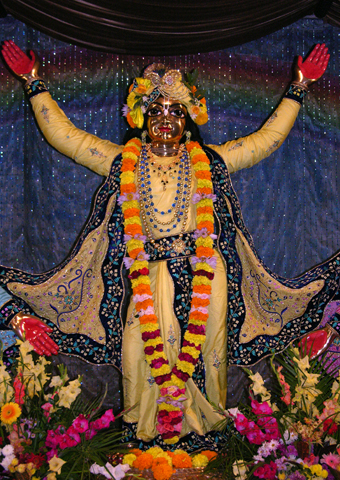|
Tatastha
In Gaudiya Vaishnavism, a sect of Hinduism, there are considered to be three primary energies of forces of existence such as the internal (spiritual), external (material), and taṭasthā which can be translated as "marginal". In this belief system, material energy can never be spiritual, spiritual energy cannot be tainted or changed in any way by matter or anything impure, however, marginal energy can associate with either spiritual or material energy. Tatastha is called marginal because although it is an expression of God's energy and hence spiritual or divine, it can actually be overcome by illusion and delusion. This is what differentiates the individual souls from God. While individual souls share God's nature, it is infinitesimal in stature compared to God. In Gaudiya Vaishnavism this is one of the definitions of what differentiates the individual from The Supreme, God cannot be corrupted, but the individual can. Marginal energy is considered to be the essential nature of ... [...More Info...] [...Related Items...] OR: [Wikipedia] [Google] [Baidu] |
Gaudiya Vaishnavism
Gaudiya Vaishnavism (), also known as Chaitanya Vaishnavism, is a Vaishnava Hindu religious movement inspired by Chaitanya Mahaprabhu (1486–1534) in India. "Gaudiya" refers to the Gaura or Gauḍa region of Bengal, with Vaishnavism meaning "the worship of Vishnu". Specifically, it is part of Krishnaism—Krishna-centric Vaishnavite traditions. Its theological basis is primarily that of the ''Bhagavad Gita'' and ''Bhagavata Purana'' (known within the tradition as the ''Srimad Bhagavatam''), as interpreted by early followers of Chaitanya, such as Sanatana Goswami, Rupa Goswami, Jiva Goswami, Gopala Bhatta Goswami and others. The focus of Gaudiya Vaishnavism is the devotional worship (known as bhakti yoga) of Radha and Krishna, and their many divine incarnations as the supreme forms of God, '' Svayam Bhagavan''. Most popularly, this worship takes the form of singing Radha and Krishna's holy names, such as " Hare", "Krishna" and "Rama", most commonly in the form of the Ha ... [...More Info...] [...Related Items...] OR: [Wikipedia] [Google] [Baidu] |
Hinduism
Hinduism () is an Indian religion or '' dharma'', a religious and universal order or way of life by which followers abide. As a religion, it is the world's third-largest, with over 1.2–1.35 billion followers, or 15–16% of the global population, known as Hindus. The word ''Hindu'' is an exonym, and while Hinduism has been called the oldest religion in the world, many practitioners refer to their religion as '' Sanātana Dharma'' ( sa, सनातन धर्म, lit='the Eternal Dharma'), a modern usage, which refers to the idea that its origins lie beyond human history, as revealed in the Hindu texts. Another endonym is ''Vaidika dharma'', the dharma related to the Vedas. Hinduism is a diverse system of thought marked by a range of philosophies and shared concepts, rituals, cosmological systems, pilgrimage sites, and shared textual sources that discuss theology, metaphysics, mythology, Vedic yajna, yoga, agamic rituals, and temple building, among other to ... [...More Info...] [...Related Items...] OR: [Wikipedia] [Google] [Baidu] |
Krishna
Krishna (; sa, कृष्ण ) is a major deity in Hinduism. He is worshipped as the eighth avatar of Vishnu and also as the Supreme god in his own right. He is the god of protection, compassion, tenderness, and love; and is one of the most popular and widely revered among Indian divinities. Krishna's birthday is celebrated every year by Hindus on Krishna Janmashtami according to the lunisolar Hindu calendar, which falls in late August or early September of the Gregorian calendar. The anecdotes and narratives of Krishna's life are generally titled as ''Krishna Leela''. He is a central character in the ''Mahabharata'', the '' Bhagavata Purana'', the ''Brahma Vaivarta Purana,'' and the '' Bhagavad Gita'', and is mentioned in many Hindu philosophical, theological, and mythological texts. They portray him in various perspectives: as a god-child, a prankster, a model lover, a divine hero, and the universal supreme being. Quote: "Krsna's various appearances as a di ... [...More Info...] [...Related Items...] OR: [Wikipedia] [Google] [Baidu] |
Caitanya Caritamrta
The ''Chaitanya Charitamrita'' (; bn, চৈতন্যচরিতামৃত, Côitônyôcôritamṛtô), composed by Krishnadasa Kaviraja in 1557, is written in Bengali with a great number of Sanskrit verses in its devotional, poetic construction, including ''Shikshashtakam''. It is one of the primary biographies detailing the life and teachings of Caitanya Mahāprabhu, the founder of Gaudiya Vaishnavism. The stories of Chaitanya's life are mixed with philosophical conversations detailing the process of Bhakti yoga, with special attention given to congregational chanting of Krishna's names and the Hare Krishna mantra. Contents The Chaitanya Caritamrta is divided into three sections: Adi-lila, Madhya-lila and Antya-lila. Each section refers to a particular phase in Chaitanya Mahaprabhu's life: Adi-lila The Adi-lila explains Chaitanya's unique theological identity (Krishna in the mood of Radharani—a combined avatar), his lineage, his closest childhood companions and the ... [...More Info...] [...Related Items...] OR: [Wikipedia] [Google] [Baidu] |
Hindu Philosophical Concepts
Hindus (; ) are people who religiously adhere to Hinduism.Jeffery D. Long (2007), A Vision for Hinduism, IB Tauris, , pages 35–37 Historically, the term has also been used as a geographical, cultural, and later religious identifier for people living in the Indian subcontinent. The term ''"Hindu"'' traces back to Old Persian which derived these names from the Sanskrit name ''Sindhu'' (सिन्धु ), referring to the river Indus. The Greek cognates of the same terms are "''Indus''" (for the river) and "''India''" (for the land of the river). The term "''Hindu''" also implied a geographic, ethnic or cultural identifier for people living in the Indian subcontinent around or beyond the Sindhu (Indus) River. By the 16th century CE, the term began to refer to residents of the subcontinent who were not Turkic or Muslims. Hindoo is an archaic spelling variant, whose use today is considered derogatory. The historical development of Hindu self-identity within the local In ... [...More Info...] [...Related Items...] OR: [Wikipedia] [Google] [Baidu] |



.jpg)